Christ is risen! Truly he is risen!
What? Saint Nicholas in May?
I explained this last year, but in case you’re new here:
May 9 is a lesser feast of Saint Nicholas. Actually Nicholas is an ever-present, ever-relevant saint to us Orthodox, not confined to December 6 – or to December 25.  By the way, who exactly is this fat jolly old elf who sells cars on TV and has stolen the identity of Saint Nicholas? If this guy (elf?) tries to pass a cheque using our saint’s name, he’s going to get into big trouble.
By the way, who exactly is this fat jolly old elf who sells cars on TV and has stolen the identity of Saint Nicholas? If this guy (elf?) tries to pass a cheque using our saint’s name, he’s going to get into big trouble.
But before we begin: Looking back at my Posts, I see I’ve used the words “I” and “my” a whole lot. Like four times in that last sentence. And I’m not ashamed. Besides writing about the teachings of Christ and the Church, which I hope I’ve presented accurately, I’ve also tried to apply the Faith. This has meant including personal opinions which are definitely not the Word of the Lord. I’ve tried to differentiate the two carefully by using first person singular. In both cases if you think I’m wrong, please say so. This is how we all learn.
In addition, I’ve been telling a lot of personal stories, so I can share with you how much God and his Church and his saints have meant for me. As follows:
Saint Nicholas in Italy
May 9 is the day in 1087, some seven centuries after his death, when Nicholas arrived in Bari, Italy. Merchants had stolen his myrrh-bearing, wonder-working relics from his home city, Myra on the south coast of Asia Minor. They told the locals they had seen a vision of Nicholas who told them he wanted to go to Italy, so goodbye – and, as the story goes, the residents cried, “Wow! We couldn’t be happier!” And if you believe that one, let me tell you another…
I think the Barian merchants saw our saint chiefly as a merchandising item: a way to draw pilgrims and make money. (It worked! I’ve been there – see Post 18 – and paid an exorbitant price for some myrrh.) But perhaps it was all for the best. They rescued Nicholas from the ever-growing Muslim threat. Bari was still Orthodox in those days, but soon came under the authority of the Pope. However, the Roman Catholics have treated him well, indeed treasured him, and that’s how he became a favorite saint also in the West.
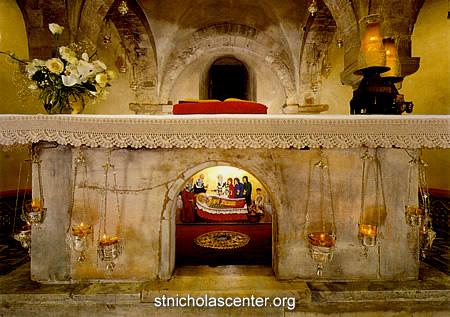
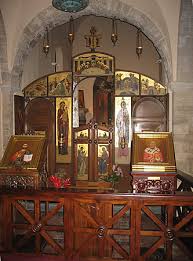
Today Holy Nicholas’ relics (those not scattered around the world) lie in the crypt of San Nikola Roman Catholic Basilica in Bari. There is an Orthodox chapel to his left, where Divine Liturgy is celebrated regularly. (God bless the Roman Catholic Bishop of Bari.) It is a holy place. You can feel the presence of Nicholas. It felt strangely like Saint Nicholas back home. Or perhaps not so strangely, which brings us at last to our story.
How Saint Nicholas Founded Saint Nicholas Orthodox Church in Cedarburg, Wisconsin, USA
The beginning of the story will be very personal.
Saint Nicholas first brought me to Holy Orthodoxy. Even before our church (no, his church) in Cedarburg existed, he was already our patron and protector. I’ve told you some of these stories before. Now let me try to pull it all together.
Looking back, I’m convinced that in the year AD 1985 earth time, the Lord Jesus must have said to Saint Nicholas, “We  need an Orthodox church on the north side of Milwaukee. Go work on that Olnhausen fellow.”
need an Orthodox church on the north side of Milwaukee. Go work on that Olnhausen fellow.”
I was definitely ready to be worked on. By 1985 I was a very frustrated Episcopal priest. I had become an Anglican in 1963 seeking “the Church”, “mere Christianity”, “ the ancient Faith”. (You have heard these terms before?) I had become convinced that Anglicanism was Church in the full sense of that word and, though currently somewhat deformed, had a vocation to become “western Orthodoxy”. In those days one could still make a serious case for this.
God bless Anglicanism for what it gave me. I love it still – as it was. Or at least as I thought it was. But by the 1980s it definitely wasn’t anymore. I saw the Episcopal Church going the opposite direction fast. I felt we, like Esau. were selling our inheritance for a “mess of pottage”, as the King James Version put it. Genesis 25:29-34 I felt Anglicanism was moving away from me. Actually, as I was to discover, I also had been moving away from Anglicanism. Both of us had changed.
Saint Nicholas works on me.
I told you in earlier Posts how I came to bring an icon of Saint Nicholas home with me from Greece, because his face was so like that of a joyful, holy, happy, loving Bishop we had visited on Crete. Though I didn’t realize it yet, I was now officially his target.
Looking back, I think he had been working on me before that. When I was a little boy, I asked my mother, “How long has Santa Claus been alive?” Being Protestant and not knowing the story of the real Saint Nicholas, she answered, “Always, I guess” – and suddenly for the first time my mind opened up to “forever”, to eternity. That came through his nephew Santa Claus, who in those days was still a mysterious wonderful figure. As I learned the story of Saint Nicholas, I came to be attached to him. At my old Episcopal Church in Mequon, Wisconsin, we always celebrated Mass on Saint Nicholas Day. On the Sunday following we had someone dress as Bishop Nicholas and collect toys for needy children.
So it felt natural when I came ![]() home from Greece to hang my new icon of Saint Nicholas on the wall of my Episcopal church and light a candle before him. Now I was about to learn how icons work.
home from Greece to hang my new icon of Saint Nicholas on the wall of my Episcopal church and light a candle before him. Now I was about to learn how icons work.
We had Evening Prayer (like Orthodox Vespers) most days, and after it one evening a woman said to me, “Have you noticed how his expression changes?” I answered, “No… …” But then I started watching him. Sure enough. Not that the paint moved – it didn’t. I can’t explain it. But sometimes he was happy, sometimes sad, sometimes stern, sometimes pleased. I dared to share this with a few friends who I hoped wouldn’t think I was “losing it”. One suggested, “It’s just reflecting your feelings at the moment.” So I began to check that. Sometimes yes, sometimes no. Sometimes I would be in a good mood, and he would be looking very displeased – or it could be the reverse.
The truth was that I was not often in a good mood. After my trip to Greece and my three-week immersion into Orthodoxy, I was realizing that Orthodoxy was my answer. Orthodoxy was what I had always believed. All these years I had been trying to be Orthodox outside the Orthodox Church. I knew I needed to go home. And while this was a wonderful discovery, I couldn’t imagine how to do it, for we had one child in college and another nearing college age, so how could we afford to make the change?
Besides, as a pastor, I felt I couldn’t just abandon my people. My parishioners were lovely. My parish was a gem, relatively untouched at that time by the massive changes going on the wider Episcopal Church. Was there a way to make my Episcopal parish into an Orthodox church? But again, I couldn’t imagine how.
Furthermore, my wife Dianna wasn’t ready for this. With me she had given herself heart, mind and soul to the Episcopal Church, even being involved in national Episcopalian affairs. Like me, she felt she had “loved and lost” – and she was not about to do that again. I had been in Greece alone, so she hadn’t shared my “conversion experience” there. So I decided, without telling her, that God’s first sign to me that Orthodoxy was the answer would be if she became truly enthusiastic about it, was not just doing it for me. (Then I would wait for another sign.) However, she knew what was going on with me. I was becoming desperate and not easy to live with.
Saint Nicholas gets moving.
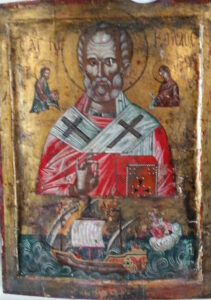
One evening I had just returned from a local Episcopal clergy conference. Now our formerly Anglo-Catholic diocese had a new bishop and was “going with the flow”, and I felt glum, depressed, frustrated, knowing I didn’t belong there any more. After Evening Prayer I walked over and looked at Saint Nicholas. You can see how through that icon he had already drawn me into relationship with him. And for the first and only time (I’ve never been able to see this again in the icon), he looked smug, like the proverbial cat who had swallowed the canary. I lost my cool. I said to him (aloud?), “How can you hang there on that wall looking so pleased with yourself, when I’m so miserable?” And then – and I don’t mean I heard words; it wasn’t like that; again I can’t explain it; this is the only time in my life I’ve experienced something like this – he told me that he had Saint Nicholas Orthodox Church well under way, and if I didn’t get in his way it was all going to be just fine.
Was I sure at the time that this experience was “real”, not just my mind running awry, a psychological aberration? Absolutely. Positively. And I still am. Why? I can’t tell you. But, like a few similar things that have come to me over the years, they are simply undeniably true. That’s all I can say. And they all have “panned out”, as they say.
After that things began to move. Not that I was relaxed about it. Far from it, often I was a nervous wreck. But deeper down, somehow I just knew Saint Nicholas had it in hand.
I made contact with some local Orthodox clergy and was ![]() invited to visit a weeping icon of the Theotokos at Saint Nicholas Albanian Orthodox Church in Chicago. Somehow that gave me the courage to go back to my Episcopal church and start talking about Orthodoxy. Peoples’ reactions ranged from interested to actively hostile. An Episcopalian clergy friend asked, “Why are you tearing up one of the best parishes in the diocese?” Sometimes I wondered myself.
invited to visit a weeping icon of the Theotokos at Saint Nicholas Albanian Orthodox Church in Chicago. Somehow that gave me the courage to go back to my Episcopal church and start talking about Orthodoxy. Peoples’ reactions ranged from interested to actively hostile. An Episcopalian clergy friend asked, “Why are you tearing up one of the best parishes in the diocese?” Sometimes I wondered myself.
Saint Nicholas works behind the scenes.
Now, for some years I had to go on faith that Nicholas was working on this – though there were some little “miracles” along the way. Looking back, I’m sure now that he was behind them.
Speaking of not keeping this a secret from my wife, in the spring of 1988 I traveled east to visit some Orthodox institutions – seminary, parish, monastery – to see if Orthodoxy was really what it seemed to be. (I had watched the denomination I loved fall apart, and I felt I couldn’t handle that twice in one lifetime.) Yes, it was. While Episcopalians were now debating whether Jesus was divine or not, at Saint Vladimir’s Seminary I heard a heated debate over whether Christ in his Incarnation had assumed fallen or unfallen human nature! It was a whole different world. And so Orthodoxy has continued to be over the years – totally grounded in the Scriptures and the Fathers.
But, were I to become Orthodox, what jurisdiction should I try to join? (It is such a shame that prospective converts have to choose among Orthodox jurisdictions. Orthodox friends in other jurisdictions always get hurt in the process.) Later that spring I saw that the Antiochian Archdiocese was sponsoring a Missions and Evangelism Conference in Santa Barbara. I really wanted to go, but thought we couldn’t afford it. I said nothing about this to anyone, not even my wife. After an early weekday Mass a woman came up to me, handed me an envelope and said, “I don’t know why I’m doing this, but I’ve been praying, and I must do it.” Inside the envelope was a check for almost exactly the amount I needed to go to the conference! I attended and met Father Peter Gillquist (+ memory eternal) who had this amazing ability to advise and handle situations. After the conference, I knew I should be Antiochian.
I needed to go to the conference! I attended and met Father Peter Gillquist (+ memory eternal) who had this amazing ability to advise and handle situations. After the conference, I knew I should be Antiochian.
About the same time my wife and the woman who have given me the money went to some classes at a local Orthodox church. I was scared to ask her about her reactions, afraid she would say “no way”, and so my sign from God would be “No”. But then one Sunday Episcopalian friends visited us. Over lunch, they vowed they would stay Episcopalian till the last dog died. (They didn’t.) To my amazement and delight, Dianna laid the virtues of Orthodoxy all over them! Another hurdle overcome. And, as if by design from on high, within a couple of weeks my Episcopal bishop sent his emissary out to ask what in the world was going on with me. I told him, honestly.
I invited Father Peter to visit my parish the next spring to speak about the Orthodox Church. (You can guess how well that went over with many people!) I told him I would call him when and if I had a final sign from God. The Sunday after Easter my Episcopal bishop fired me for promoting Orthodoxy. Actually he gave me a choice of resignation or an ecclesiastical trial. “On what charge?” I asked. I hadn’t broken any canon laws. “Apostacy”, he answered. This in a church that tolerated bishops who denied the Divinity of Christ, the Virgin Birth and the Resurrection! I’m afraid that I started to laugh. And also to tremble. I was now officially scared. I called Father Peter and said, “I think I’ve got my sign.”
I resigned, but told my Episcopal parish I wasn’t leaving without that icon of Saint Nicholas. By this point they were glad to be rid of it! And of me. Thus far Nicholas hadn’t directly manifested his presence to me again, so I had to ride on faith. But he seemed to have things in hand. That summer some of us met to try to organize a new mission. With Father Peter’s guidance and the blessing of His Eminence Metropolitan Philip, 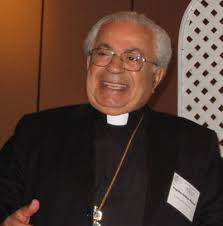 His Grace Bishop Antoun left (both, now, of blessed memory +) came out in September and founded our Orthodox mission. I worried how our mostly Anglo group of converts would relate to an old country Arab bishop. Within five minutes he had them “eating out of the palm of his hand.” What a charming man! However, after he had seen our little group of “chrismatees”, he whispered to Father Peter, “Is that all there are?” Yes, that was all.
His Grace Bishop Antoun left (both, now, of blessed memory +) came out in September and founded our Orthodox mission. I worried how our mostly Anglo group of converts would relate to an old country Arab bishop. Within five minutes he had them “eating out of the palm of his hand.” What a charming man! However, after he had seen our little group of “chrismatees”, he whispered to Father Peter, “Is that all there are?” Yes, that was all.
Saint Nicholas re-emerges.
Father Tom Hopko (also of blessed memory +) from Saint Vladimir’s Seminary, who had been a big help to me along the way (that’s another story) but knew nothing of our Saint Nicholas connection, sent us a relic of Saint Nicholas, which is now embedded in our altar. We submitted three names for our new church to Metropolitan Philip, who named us Saint Nicholas Church. When we bought a former Lutheran building and needed to make it workable for Orthodox use, we aimed to have our first services on the next major feast day which turned out to be Saint Nicholas Day.
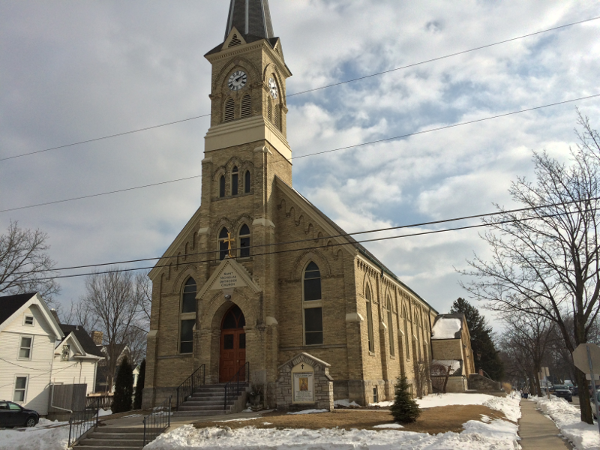
Yes, we could use an Orthodox dome as opposed to a Lutheran steeple, but first we’re “Orthodoxifying” the interior, below. We have had icons written in traditional egg-tempura style which should last a few centuries at least. God willing, and with the help of Saint Nicholas, we plan to be around for a while.
![]()
Since we began, the money we need has always just arrived, often in very unexpected ways (that’s yet another story), for which one of our early treasurers coined the term “the Saint Nicholas factor”. It (he!) still kicks in regularly. When there have been problems, I have gone to Saint Nicholas, and good results have come. Twice, when I mentioned to him just in passing that we needed more young couples and young families, it took a couple of weeks for the surge to begin. Once when there was a problem that could have seriously endangered the parish, I went to Saint Nicholas – ok, I bribed him with $50 for a candle – and within hours the issue resolved.
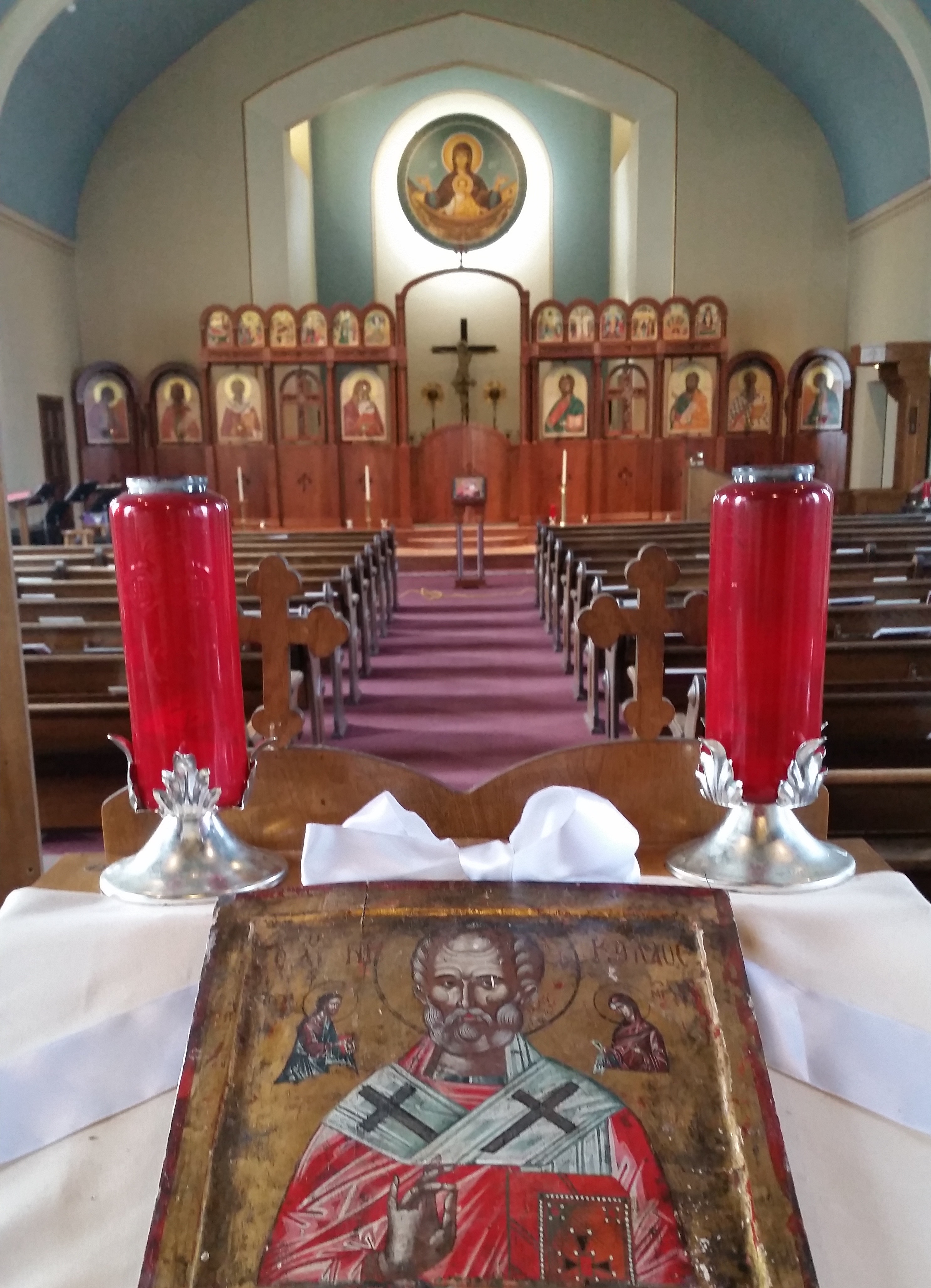
That wonderful icon I bought in 1985 presides now at the entrance to our church – since this picture was taken we have housed him in a box, because he was getting kissed out of existence – to make the point that this truly is Saint Nicholas’ Church. This is not our church. It’s his. We’ve worked hard, certainly, but this has been his work. When I look at him now, there seems only to be a benevolent look on his face. It doesn’t change.
One last thing: After all this had happened, one August Khouria Dianna and I were at Milwaukee Irish Fest (the biggest Irish music and cultural festival in the world – in Milwaukee?!). There we came across a genealogical table with a sign which read, “Trace your family roots.” My mother was a Collins. So I looked at the chart, and my mouth fell open. It said: “Collins: derivative of Nicholas”! Was Saint Nicholas working on all this even before I was born? ? ?
So when we sing “Holy Father Bishop Nicholas, pray to Christ our God that he may save our souls”, God and Saint Nicholas know that I mean it with all my heart.
Next Week: The Paschal Sunday Gospels – Saint Joseph of Arimathaea, Nicodemos and the Holy Myrrhbearing Women
Week after next: The Paschal Sunday Gospels – the Paralytic
Love it!!
Thank you, Mama V. I’m glad to hear from you – or anybody! Readership is way down since Holy Week. (We Bloggers have our ways of knowing these things…) I think everybody is just wiped out. Me too.
Father, bless. A wonderful story! Even better the second time around.
your servant in Christ,
Deacon…..wait for it……Nicholas
I had fallen away from Orthodoxy for nearly 20 yrs, a few years back I kept finding Orthodox icons at resale shops as I was getting back into the faith and needed affordable icons, they keep showing up. One day I found a framed photograph someone had taken of a weeping icon of the Theotokos and there was an icon of a male saint next to hers. I showed it to my priest and he said, “that’s the weeping Panagia icon at St Nicholas Albanian Church, that man is St Nicholas next to her.” I happened to look at my Baptismal certificate sometime later and was shocked to see I had been baptized there in 1975. What a coincidence, thank you for you prayers Panagia and St Nicholas for bringing me back home to Orthodoxy!